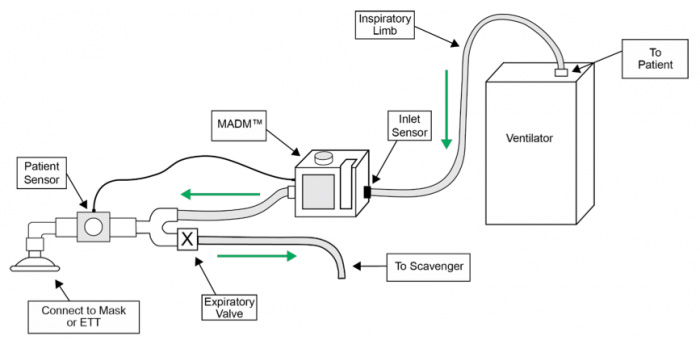MOVES® SLC™ in the Surgical Setting: Anesthesia Integration with MADM™
MOVES® SLC™ can also be used to provide primary life support during surgery. MOVES® SLC™ was designed based upon the functionality of anesthesia workstations typically found in civilian hospitals, and whose functionality is well understood by both civilian and military anesthesia providers. Using MOVES® SLC™ in the surgical setting further extends a seamless continuum of care.
MADM™ is a mobile anesthesia delivery module that is placed in the inspiratory limb of any ventilator to supply vapor anesthetics (isoflurane or sevoflurane) to patients requiring sedation or anesthesia during surgery.
When MADM™ is integrated with MOVES® SLC™ for providing gas anesthesia there are significant advantages over other solutions due to the closed-circuit ventilator configuration that is created, particularly important in military and disaster relief situations.
Closed-Circuit Ventilator Configuration Advantages
When MADM™ is used in a closed-circuit configuration, with a ventilator such as the MOVES® SLC™, vapor anesthetic that is not consumed by the patient is exhaled back into the circuit and becomes part of the next breath. The inlet anesthetic sensor on MADM™ will detect and measure the amount of vapor anesthetic still in the circuit and will in turn reduce the amount of liquid anesthetic it is vaporizing as less vapor anesthetic is required. Using MADM™ in a circle-circuit configuration will result in substantial savings in the amount of liquid anesthetic required and will greatly reduce or eliminate the requirement to exhaust waste anesthetic gas.
What’s more, MADM™ sensors will detect and measure anesthetic in the system and will adjust delivery accordingly. This feature is of critical importance in volatile and less controlled environments where medical personnel are often charged with treating multiple patients at once and need a system with internal controls set to their specifications.
MADM™ does not require inline temperature control because it does not rely on evaporation of the anesthesia. MADM™ recognizes what agent is being used and maintains the heater plate at the exact temperature required to vaporize the anesthetic, regardless of the environmental temperature.



MADM™: Open Circuit Ventilator Configuration Also Possible
If preferred, MADM™ can integrate with any open circuit ventilator in an open-circuit configuration. In this scenario, the liquid anesthetic required by MADM™ to maintain a patient’s anesthesia level is greater than when used in a closed-circuit configuration, as anticipated. And, in the same way that an open- circuit ventilator will not retain the excess O2 that is not consumed by the patient and exhaled, any vapor anesthetic delivered by MADM™ but not consumed by the patient is also lost. This is appropriate for an environment where waste anesthetic gas pollution can be managed effectively and availability of O2 is not of.
In this configuration, the operation of MADM™ is the same as it will adapt to the type of ventilator is it connected to. MADM™ still monitors the concentration of anesthetic in the circuit and continues to vaporize anesthetic as needed at an optimal temperature.


